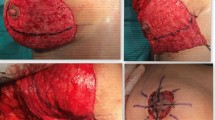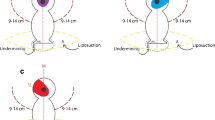Abstract
Background
Reduction mammoplasty using the inferior pedicle technique has been used for more than five decades. Without doubt, it has many advantages, especially in patients with moderate to severe macromastia. Although the esthetic outcome of reduction mammoplasty in the early postoperative period is usually satisfactory, typical esthetic drawbacks appear during the first year. These drawbacks include bottoming out, loss of superior fullness, box-shaped breasts, poor definition of the infra-mammary fold (IMF), elongation of the vertical scar, star gazing of the nipple-areola complex (NAC) and, of course, the scar burden. Parenchymal reshaping and suspension have been introduced as an additional step to eliminate the drawbacks of the inferior pedicle procedure.
Methods
This is a prospective study done in a period from March 2016 to March 2018 in Kasr Al-Ainy Hospital (Cairo University hospitals) by the senior author and his team of co-authors. Reduction mammoplasty (Wise pattern) with the inferior pedicle and dermal wrap technique (using two dermal wings) was performed in 20 patients. The distance from the suprasternal notch (SSN) to the NAC was > 30 cm.
Results
The patients’ ages ranged from 28 to 55 years (average age, 39 years). Body mass index (BMI) ranged from 27 to 35 kg/m2 (average BMI, 33.3 kg/m2). The distance between the SSN and NAC ranged from 33 to 45 cm (average distance, 40 cm).
The nipples were lifted by 11 to 19.5 cm. The distance from the nipple to the IMF ranged from 18 to 24 cm. This distance was reduced postoperatively to between 9 and 11.5 cm (p value < 0.001).
Conclusions
Follow-up of the patients revealed that suspension of the breast parenchyma and plication of the dermal flap improved the esthetic results following inferior pedicle breast reduction.
The addition of volumetric and geometric adjustment “preoperatively” may significantly improve the results and minimize the operative time of this relatively lengthy procedure (4–6 h for both breasts).
Level of Evidence: Level IV, terapeutic study.






Similar content being viewed by others
Change history
23 February 2019
The authors wish to clarify that Dina M. Badwai refers to Dina M. Badawi. The authors apologise for this error.
References
Chan YH (2004) Biostatistics301: repeated measurement analysis. Singap Med J 45(8):354–369
Courtiss EH, Goldwyn RM (1977) Reduction mammaplasty by the inferior pedicle technique: an alternative to free nipple and areola grafting for severe macromastia or extreme ptosis. Plast Reconstr Surg 59:500–507
Pennington DG (2006) Improving the results of inferior pedicle breast reduction using pedicle suspension and plication. Aesthetic Plast Surg 30:390–394
Ding H, Wang B, Gu Y, Zhao Y (2015) The combination of inferior pedicle method and dermal suspension sling technique : one new efficient method for breast reduction. Int J Clin Exp Med 8(4):6613–6620
Echo A, Guerra G, Yuksel E (2011) The dermal suspension sling: shaping the inferior pedicle during breast reduction. Aesthetic Plast Surg 35:608–616
Kankaya Y, Oruc M, Sungur N, Aslan O, Gurosy K, Ozer K, Kocer U (2016) Four flap suspension technique for prevention of bottoming out after breast reduction. Ann Surg Treat Res 90(1):10–15
Makboul M, Abdelhamid M, Al-Attar G (2017) Long term follow up and patient satisfaction after reduction mammoplasty: superomedial versus inferior pedicle. World J Plast Surg 6(1):82–87
Nahabedian MY, Mofid MM (2002) Viability and sensation of the nipple-areolar complex after reduction mammaplasty. Ann Plast Surg 49:24–31
Robbins TH (1984) Inferior pedicle breast reduction technique. Plast Reconstr Surg 73:325
Temel M, Karakaş, Dokuyucu R, Türkmen A (2015) The dermal internal brassiere flap, a new modification of inferior pedicle breast reduction technic. Aesthetic Plast Surg 39:350–358
Funding
This research did not receive any specific grant from any funding agency in the public, commercial, or not-for-profit sector.
Author information
Authors and Affiliations
Corresponding author
Ethics declarations
Ethical approval
Ethical approval from a local ethics committee was obtained for this study.
Informed consent
Written and verbal consent was obtained from the patients.
Conflict of interests
Tarek Mahboub and Rama Ahmed declare that they have no conflict of interest.
Additional information
Publisher’s note
Springer Nature remains neutral with regard to jurisdictional claims in published maps and institutional affiliations.
Rights and permissions
About this article
Cite this article
Mahboub, T., Ali, R.A., Badawi, D.M. et al. Optimization of the dermal wrap in inferior pedicle reduction mammoplasty: An Egyptian experience. Eur J Plast Surg 42, 259–264 (2019). https://doi.org/10.1007/s00238-019-1496-6
Received:
Accepted:
Published:
Issue Date:
DOI: https://doi.org/10.1007/s00238-019-1496-6




